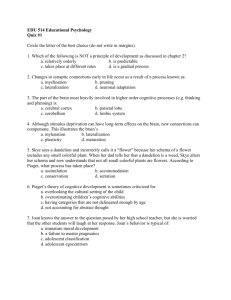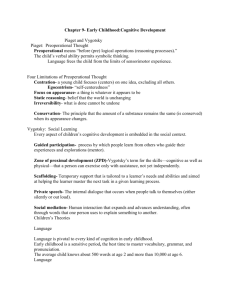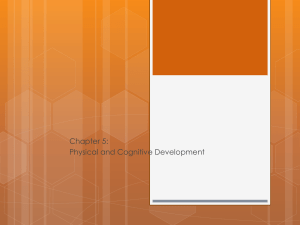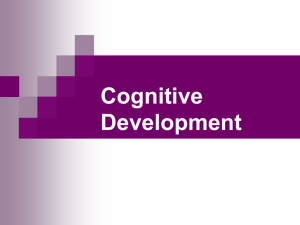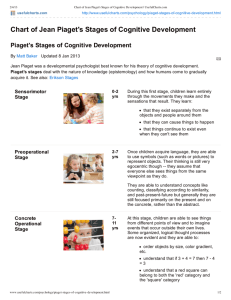Rathus CDEV Chapter 9
advertisement
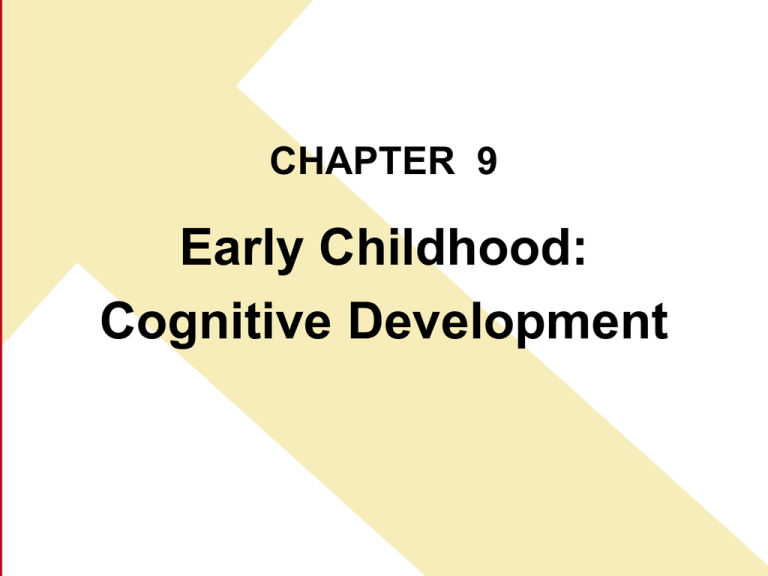
CHAPTER 9 Early Childhood: Cognitive Development Learning Outcomes LO1 Outline the cognitive developments of Piaget’s preoperational stage. LO2 Discuss factors in cognitive development, focusing on Vygotsky’s views and the effects of the home environment, early childhood education, and television. LO3 Discuss the development of theory of mind, including false memories, origins of knowledge, and the appearance–reality distinction. LO4 Discuss memory development during early childhood, including strategies for remembering. LO5 Outline language development during early childhood and explain the interactions between language and cognition. © Peter Mason/Getty Images TRUTH OR FICTION? • • • • • T-F A preschooler’s having imaginary playmates is a sign of loneliness or psychological problems. T-F Two-year-olds tend to assume that their parents are aware of everything that is happening to them, even when their parents are not present. T-F “Because Mommy wants me to” may be a perfectly good explanation for a a 3-year old. T-F Children’s levels of intelligence, not just their knowledge, are influenced by early learning experiences. T-F Three-year olds are likely to say “Daddy goed away” instead of “Daddy went away” because they do understand rules of grammar. © iStockphoto.com LO1 Jean Piaget’s Preoperational Stage. © Peter Mason/Getty Images Jean Piaget’s Preoperational Stage • 2nd Stage in Piaget’s Theory of Cognitive Development: Preoperational Stage • Age 2-7 years: Early Childhood • Includes concepts of: – Symbolic Functioning – Egocentrism – Centration Jean Piaget’s Preoperational Stage • Symbolic Thought – Using symbols to represent objects and relationships • Most important type of symbolic activity: language • Drawings are also symbols of objects, people, events • Symbolic or Pretend Play © Tammy Bryngelson/iStockphoto.com • Around 1 year children may pretend they are sleeping or eating (focus is on self). • By 15-20 months focus shifts from self to others (pretending to feed doll). • By 30 months they can pretend the doll feeds itself (objects take an active role). Jean Piaget’s Preoperational Stage • Symbolic or Pretend Play, con’t. – Imaginary Friends • 65% of preschoolers have imaginary friends • Most common among firstborn or only children • Children with imaginary friends are: – Less aggressive; more cooperative; more creative; have more real friends; have better concentration; are more advanced in language development – Implications of Pretend Play • Quality of pretend play is connected to later academic performances, creativity, and social skills • Those who engage in violent Pretend Play are less empathic and more likely to engage in antisocial later on. Jean Piaget’s Preoperational Stage • Egocentrism: It’s All About Me – Preoperational children do not understand that other people may see the world differently than they do. – They think in one-dimensional terms which leads to viewing the world only from their own perspective. – The “Three Mountains Test” exhibits that children 5-6 yrs old can only relate information from their existing viewpoint. Jean Piaget’s Preoperational Stage • Three Mountains Test: – Child is shown a table with models of 3 mountains on it. – Each mountain is a different color, one has a house on it, and another has a cross on top of it. – A doll is placed across the table from the child (if the doll could see, it would have a different view of the scene). – The child is asked what the doll sees. – Since language abilities are not developed enough for a child at this stage to provide verbal descriptions of objects or events they are directly observing, they can answer in one of two ways: • By selecting a photo taken from the dolls view • Or by constructing another model of the mountains as they would be seen by the doll • The child usually selects a photo or builds another model that corresponds to their own viewpoints. Figure 9.1 - The Tree-Mountains Test Jean Piaget’s Preoperational Stage • Egocentrism: It’s All About Me, con’t. – Causality: (other facets of egocentrism) • Precausal: When preoperational children are asked questions about events and they do not know the natural causes of those events, their answers are likely to have an egocentric flavor and not be based on science. • Transductive Reasoning: Children at this stage will “reason” by going from one specific isolated event to another. They will attribute “cause-and-effect” to totally unrelated events. • Animism: Children will attribute life and intentions to inanimate objects at this stage. • Artificialism: The child assumes that environmental features such as rain and thunder have been designed and made by people Jean Piaget’s Preoperational Stage • Egocentrism: It’s All About Me, con’t. – Confusion of Mental and Physical Events: (other facets of egocentrism) • 2-4 years: children show confusion between symbols and the things they represent • Egocentrism contributes to the assumption that their thoughts exactly reflect external reality. • They do not recognize that words are arbitrary and people can use different words to refer to the same objects. Jean Piaget’s Preoperational Stage • Conservation: – The law of conservation holds that properties of substances such as volume, mass, and number remain the same, or are conserved, even if you change their shape or arrangement. – Centration • Conservation requires the ability to focus on two aspects of a situation at once, such as height and width. • Preoperational children tend to focus on only one aspect of a problem at a time. – Irreversibility • The preoperational child does not understand that things can be restored to their original condition. – Class inclusion • Including new objects or categories in broader mental classes or categories • Preoperational children are not yet capable of focusing on two aspects of a situation at the same time. Figure 9.2 - Conservation Figure 9.3 - Conversation of Number LO2 Factors in Cognitive Development. © Peter Mason/Getty Images Factors in Cognitive Development • The “HOME” Environment: – An acronym for The Home Observation for the Measurement of the Environment – A testing tool developed to evaluate the effects of a child’s home environment on their cognitive development. – Parent/child interactions are directly observed in the home; the inventory contains six subscales. – The HOME inventory is a better predictor of later IQ scores than social class, mother’s IQ, or infant IQ scores. – Early learning experiences affect children’s levels of intellectual functioning. – The home environment is the single most important predictor of scores on IQ tests in children ages 3-8 yrs. Table 9.2 – Scales of the HOME Inventory Factors in Cognitive Development • Effects of Early Childhood Education: – Preschool education enables children to get an early start on achievement in school. – Programs that involve and educate parents are particularly beneficial. – Effects of Poverty • Children raised in poverty generally score lower on IQ tests and are at greater risk for school failure. • Environmental enrichment can enhance the cognitive development of economically disadvantaged children. – Head Start • Federally funded program started in 1960s for low income families • Designed to increase readiness for elementary school • Head Start and similar programs are effective and lead to gains in in school readiness and achievement tests. Factors in Cognitive Development • Effects of Television: – Hours • American children spend more time watching TV than they do in school. • By age 3 yrs, the average child watches 2-3 hrs of TV a day – Children’s Television Act (1990) • Requires networks devote 3 hours per week, between 7 a.m. and 10 p.m., to educational television. • Sesame Street is the most successful example; it’s shown to increase intellectual growth in preschool children, especially those in lower SES. – Commercials • Preschoolers cannot differentiate between content of commercials and programming. • Commercials encouraging nutritionally inadequate foods are harmful to their nutritional beliefs and diets. LO3 Theory of Mind © Peter Mason/Getty Images Theory of Mind • A “common sense” understanding of how the mind works – Knowing the difference between real and mental events – Knowing the difference between how things appear and how they really are – Being able to infer perceptions, thoughts, and feelings of others – Understanding that mental states affect behavior Theory of Mind • Research shows preschoolers can accurately predict and explain human action and emotion in terms of mental states – Indicators: • False Beliefs: – By age 4-5 yrs, most children are able to separate their beliefs from those of another person who has false knowledge of a situation. • Origins of Knowledge: (how we acquire knowledge) – By age 3 yrs, realization that people gain knowledge about something by looking at it – By age 4 yrs, understand the distinction between senses: color through eyes, weight through feeling, etc. • The Appearance-Reality Distinction: – Knowing the difference between reality and fantasy or misleading appearances – Piaget believed this did not occur until age 7-8 years Figure 9.4 – False Beliefs LO4 Development of Memory. © Peter Mason/Getty Images Development of Memory • Age 1-2 yrs: – Can remember specific events called autobiographical memory or episodic memory – Are facilitated by talking about them with others – But are seldom retained into adulthood • Age 3 yrs: – Can present coherent, orderly accounts of familiar events • Scripts: abstract, generalize accounts of recurring events; lacking in detail; not case specific – Scripts begin forming after a single event and get more elaborate with repeated experience. • However, unusual events (something traumatic or highly emotional) may be remembered in specifically in detail for years. • Age 4 yrs: – Can remember events that happened at least 1.5 years earlier Development of Memory • Factors Influencing Memory – Interest Level • Children typically show better recognition and recall for preferred toys – Retrieval Cues or Reminders • Easier to remember events that follow a fixed, logical order • Using a computer analogy: you must have a name for a file in order to locate it; the name is the retrieval cue • Young children depend of elders to help them retrieve memories – Asking questions and elaborating on the child’s experience aid in child’s ability to remember – What Measure of Memory is Used • Verbal reports, especially from preschoolers, appear to underestimate the child’s memory. • Using “props” to reenact an event shows better recall ability Development of Memory • Memory Strategies: Remembering to Remember – Rehearsal: • The act of repetition: saying something over and over helps to integrate the memory into long-term memory • Typically use of rehearsal begins about age 5 – Organization: • Assigning categories to things • Grouping objects into related categories aid in remembering • Even 3-4 year olds will use both rehearsal and organization if they are asked to remember something LO5 Language Development: Why “Daddy Goed Away” © Peter Mason/Getty Images Language Development • Development of Vocabulary – Preschoolers learn an average of 9 new words a day. • Fast-Mapping – Process whereby the child quickly attaches a new word to its appropriate concept • Whole-Object Assumption – They also assume that words refer to whole objects and not to their component parts or characteristics. • Contrast Assumption – Also known as the mutual exclusivity assumption – Children will seem to assume that objects have only one label. – Therefore new words must refer to unfamiliar objects, not ones that are already named Language Development • Development of Grammar – Age 3: “grammar explosion” occurs – Sentence structure expands to include missing words as seen in telegraphic speech. – By age 3-4, children show knowledge of rules for combing phrases and clauses into complex sentences. – Over-regularization • Children acquire grammatical rules as they learn language. • At younger ages they tend to apply the rules rather strictly, not allowing for exceptions. • This leads to errors such as incorrect past tense and pluralization use. Language Development • Asking Questions: – Children’s first questions are telegraphic and characterized by a rise in pitch. – Consistent with general cognitive development: • End of 3rd year: begins the “what, who, where” questions • By age 4, they begin to ask the “why, when, which, and how” questions. – Later on, the child will add the auxiliary verbs to indicate present, past, or future tenses. © Blend Images/Jupiterimages Language Development • Passive Sentences: – 2-3 yr olds have difficulty understanding passive sentences and almost never use them. – Even at 5-6 yrs, they usually will not use. • Pragmatics: – Refers to the practical aspects of communication – Children show pragmatism when they adjust their speech to fit the social situation. – They will show more formality in word choice and syntax when role-playing high-status figures. – Once children are able to perceive the world through the eyes of others, they advance in ability to make themselves understood. Language Development • Language and Cognition • Piaget believed cognitive development precedes language, arguing that children must first understand concepts before using words to describe them. • Some studies support that theory: for example, the vocabulary explosion seen at 18 mos is related to the child’s ability to group objects into categories – Language First? • Other researchers argue that children create cognitive classes to understand things that are already labeled by words. © Don Bayley/iStockphoto.com – Cognition First? Language Development • Language and Cognition, con’t. – Currently most developmental researchers find value in both views. • In the early stages of language development, concepts often precede words (many first words describe classes that have already developed). • But later language skills reflect that language influences thought – Vygotsky • Inner Speech • The ultimate binding of language and thought • Involved in development of planning and self-regulation and facilitates the learning process – At first, children’s thoughts are spoken aloud. – 3-year olds talk out loud to themselves to regulate behavior. – Gradually by age 6-7 spoken words become internalized.

